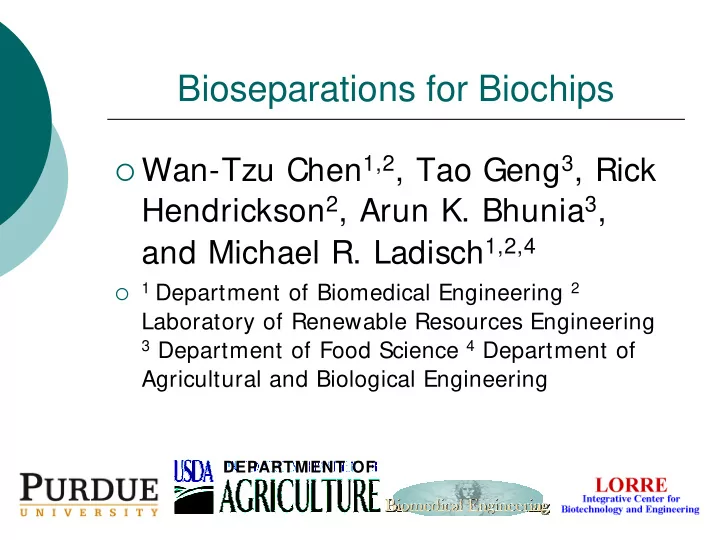

Bioseparations for Biochips � Wan-Tzu Chen 1,2 , Tao Geng 3 , Rick Hendrickson 2 , Arun K. Bhunia 3 , and Michael R. Ladisch 1,2,4 � 1 Department of Biomedical Engineering 2 Laboratory of Renewable Resources Engineering 3 Department of Food Science 4 Department of Agricultural and Biological Engineering DEPARTMENT OF
Acknowledgement This research was supported through a cooperative agreement with the ARS of DEPARTMENT OF the United States Department of Agriculture project number 1935-42000- 035 � Dr. Richard Linton (FSEC at Purdue University) � Dr. Rashid Bashir � Debby Sherman and Chia-Ping Huang � LORRE group
Introduction � Foodborne pathogens � Pathogens associated with food � Cause huge social capital annually � Time-consuming procedures for conventional techniques � Need faster and more accurate detection
Introduction � Listeria monocytogenes � Gram-positive, rod-shaped bacterium � Highly acid/salt-resistant � Cause listeriosis 1 µ m � Average death rate of 20~ 30 % � Especially harmful for pregnant women � Occur in milk, cheese and ready-to- eat dairy food via post-processing contamination
Rationale � Food proteins might block the binding sites on the chips and prevent accurate binding of Listeria to antibody. � To insure the samples flowing through chips contain only microorganisms. � Target organism needs to be concentrated to enhance detection sensitivity
Main Research Objectives Use chromatographic resins for micro-scale separation � Remove proteins and clean the Remove proteins and clean the � sample broth sample broth � Concentrate target microorganisms Concentrate target microorganisms �
Reverse-Phase Chromatography � Common analytical method for protein analysis. � Hydrophobic hydrocarbon chains on silica beads. � Components elute out in the decreasing order of polarity. � Gives fingerprint of proteins in sample
Hotdog Meat (HDM) Broth � Blend the hotdogs � Blend the hotdogs with PBS buffer (pH with PBS buffer (pH 7.4) 7.4) � Centrifuge � Centrifuge Oil � Filter � Filter � Analyze the protein � Fat Analyze the protein contents contents Aqueous fraction Solid
Fingerprint of Protein Chromatogram Minutes AU
Cation vs. Anion Exchange Adsorbents � Cation ion exchanger HSO 3 - � Negatively charged surface Proteins HSO 3 - to grab positively charged Resin proteins. HSO 3 - N + (CH 2 CH 3 ) 2 � Anion ion exchanger Proteins N + (CH 2 CH 3 ) 2 � Positively charged surface Resin to grab negatively charged N + (CH 2 CH 3 ) 2 proteins
List of Resins Examined in this Work -IRA 120+ -Butyl 650S Cationic Hydrophobic -Amberlyst 35 ion Resin -SP 550C exchanger -DEAE cellulose -Amberlite IRN Anionic ion Bifunctional 150 -DEAE 650M exchanger Resin -Hydroxylapatite -QAE 550C -Super 650M -IRA 400 Amberlite XAD2 Reversed- -Silica Phase Resin
Protein Removal � Mix resin with HDM broth � Incubate at pH 7.4 for several time intervals � Filter the samples � Analyze protein concentration � Bradford protein assay � Reverse-phase chromatography
Protein Removal-Protein Assay 120 Protein remaining% 100 0 min 80 30 min 60 40 90 min 20 0 Amberlyst 35 DEAE cellulose (strong cation) (weak anion) Resins
Strong and Weak Ion Exchanger Cation Strong cationic exchanger Weak cationic Capacity exchanger � pH effect on ion exchanger pH=7.4 capacity Anion Strong anionic exchanger Capacity Weak anionic exchanger Ladisch, 2001
What’s next? � Non-specific protein removal achieved by chromatographic resins � Specific L. monocytogenes capture by smaller spheres
Specific L. monocytogenes Capture by Immunomagnetic Separation (IMS)
Immunomagnetic Separation Bugs Streptavidin Biotin-Ab Streptavidin Listeria Biotin-Ab coated beads monocytogenes (2.8 µ m)
ELISA test of binding chemistry Substrate Color change (OPD) ExtrAvidin-Peroxidase Biotin Protein A C11E9 or P66 Antigen on plate (surface proteins)
Results of ELISA test Ag+Biotin-proteinA-P66 Ag+Biotin-proteinA-C11E9 Ag+biontin-P66 Ag+Biotin-C11E9 Ag+Extravidin-peroxidase P66+Ag C11E9+Ag 0 0.5 1 1.5 2 2.5 3 Abs 490 nm
Fluorescence test � Use of fluorometer to differentiate layers � Procedures: � Beads+ biotin-Protein A+ C11E9 or P66 � Use of FITC labeled Anti-mouse IgG to verify the binding
Results of Fluorescence test Beads+Biotin-Protein A+P66+FITC Anti- mouse IgG Beads+Biotin-Protein A+C11E9+FITC Anti-mouse IgG Empty beads+P66 Empty beads+C11E9 0 50 100 150 200 AU
From ELISA and Fluorescence tests � Protein A helps the chemistry of binding � Polyclonal antibody is more active than monoclonal antibody � Need to test Listeria capture
L. monocytogenes capture I noculum C11 E9 P66 capture (cfu/ 200 µ l) level capture ( cfu/ 200 µ l) ( cfu/ ml) 203 11 6 2030 134 49 20300 786 381 203000 6440 4960 2030000 66700 52800
Conclusion � Most protein uptake by strong cationic exchanger suggests that HDM might contain more positive charged proteins � Protein A enhance the binding of antibody to beads � Listeria monocytogenes capture as low as 200 cells/ml can be achieved � IMS can also concentrate the pathogens to small volumes
Protein Removal by Resins
Protein Removal-RPC 160 Protein remaining 140 120 100 0 min 80 (%) 60 30 min 40 20 90 min 0 Amberlyst 35 DEAE (strong cation) cellulose (weak anion) Resins
Conclusions-protein removal � Different resins adsorb proteins from HDM broth � Most protein uptake by strong cationic exchanger suggests that HDM might contain more positive charged proteins � Food protein removal is crucial in foodborne pathogen detection
Comparison of lightness Empty beads Beads+biotin-C11E9 Beads+biotin- Beads+FITC-Ab C11E9+FITC-Ab
Recommend
More recommend